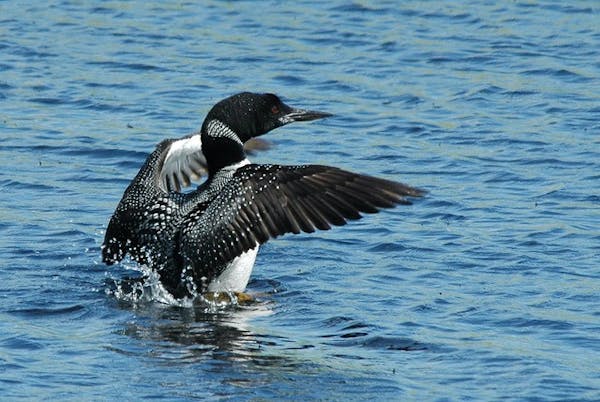Q: I recently found a loon egg on the shore in front of our cabin, which is strange, because the loon nest is located on the other end of the lake. Any thoughts?
A: It's a shame about the loon egg, and I'm thinking a predator may have stolen it out of the loon's nest, then dropped it near your cabin for some reason. There's a long list of creatures that prey on loon eggs, including raccoons, ravens, bald eagles, mink, gulls, crows, skunks and foxes. Once the chicks hatch and start swimming, you can add snapping turtles, northern pike and muskies to the list. A loon has to beat pretty heavy odds in order to reach adulthood.
Couldn't 'dees save energy?
Q: Something puzzles me about the birds at my feeders. I notice that finches will sit on the feeder eating seeds for long periods, while chickadees fly in, get one seed, and then fly off. This doesn't seem to make sense, given the high energy demand of constantly flying back and forth, especially in the winter. The finch strategy seems much more conducive to survival.
A: I like how observant you are of the birds coming to your feeders, and you're right, finches have a very different feeding style from chickadees. It comes down to their beaks: House finches and goldfinches have good, sturdy beaks, built for crushing seed shells to get to the good stuff inside. Chickadee beaks are much smaller and function best when the little birds snatch a seed from a feeder, then perch on a branch with the seed between their toes. They peck it open with their tiny beaks, then eat the seed meat inside. This surely is more energy-expensive than the finch approach, but it works for chickadees.
Osprey nests
Q: I spotted an osprey nest on top of a light pole in a park and it made me wonder: Do osprey reuse their big stick nests?
A: Yes, they do reuse their nests, and add new sticks before each new nesting season. These big fishing hawks prefer to nest on tall trees near water, but sometimes use light towers, channel markers and human-made nest platforms.
No broken eggshells
Q: Why don't I see broken eggshells in the cardinal and bluebird nests on my property?
A: Good question, and you're right, the eggshells disappear soon after chicks break out. Parent birds either eat the shells (female birds have depleted calcium levels after laying eggs) or discard them away from the nest. Otherwise, the broken shells might jab hatchlings, and could catch a predator's eye.
Beaks, not teeth
Q: Why don't birds have teeth? Doesn't this restrict what they can eat?
A: Birds seem to manage quite well without teeth to grind up their food. Turns out that birds' ancestors had teeth, 100 million years or so ago, but they slowly evolved beaks to replace teeth. It used to be accepted that this was necessary in order to keep birds' weight low, thus allowing for flight. But that theory is no longer widely accepted — after all, bats have jaws and teeth and fly quite well. Birds' gizzards perform the same function as teeth by grinding up the food they swallow, allowing them to dine on seeds, insects, fruit, berries and other foods with ease. We don't really know why birds lost their teeth, but scientists are studying the question.
White-winged crow
Q: An interesting-colored crow often visits our yard with his or her companions. Much of the underside of its wings is a light cream color, instead of the usual black. I was wondering if you've heard of anything like this.
A: It's not all that unusual for a crow to have white undersides to its wings. In fact, there used to be a web page titled "White winged crows" that kept up with many reports from observers. I no longer can find the page, but if you google "white-winged crows," you'll find many sites and reports of such birds. This sounds like a form of leucism, which is generally thought to be a genetic mutation.
Plant natives for birds
Q: I am passionate about native plants and gardens. As you know, insects provide birds with a large share of their nutrition. For example, hummingbirds don't live on nectar alone, they need insects for protein, vitamins and other nutrients. I hope you will encourage people to plant at least a few native plants and discourage them from using pesticides. We've all noticed a decrease in songbirds and in butterflies and other pollinators — what kills one insect kills them all.
A: Your points are very well taken. If we want to continue to see birds in the natural world, then we need to support the insects that sustain them, especially during nesting season. Planting native plants that nurture native insects is a good start. We'll keep making the case for native plants and insects on this page.
St. Paul resident Val Cunningham, who volunteers with the St. Paul Audubon Society and writes about nature for local, regional and national newspapers and magazines, can be reached at valwrites@comcast.net.
Singing, ceremonies and straw hats: Olympics opening ceremony in Tahiti centers Polynesian culture

Three 101-year-old friends recall fond memories in 1940s Alexandria
Celine Dion makes musical comeback at Paris Olympics with Eiffel Tower serenade






